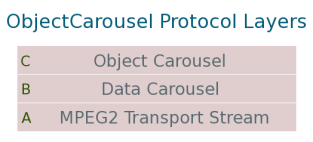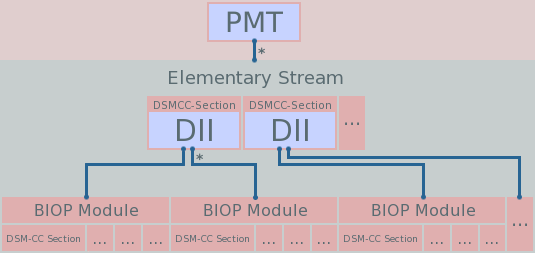DSM-CC Object Carousel Protocol: Difference between revisions
m (+cat) |
(some reworking) |
||
| Line 1: | Line 1: | ||
| ⚫ | |||
The DSM-CC ObjectCarousel protocol is a '''broadcast protocol''' on top of '''MPEG2'''. |
|||
The [[DSM-CC|DSM-CC standard/toolkit]] defines or extends five distinct protocols to cover the many different aspects of broadband service delivery. One of those five includes the "Download" Protocol, which itself contains several variations that detail the transfer of content from a server to a client, either within the [[MPEG-2 Transport Stream|MPEG-2 TS]] or independently in a separate channel. One of these "Download" protocol variations is an autonomous "data carousel", and an extension to the data carousel itself is the "object carousel". |
|||
It is used for transmission of filesystem hierarchies over a MPEG2 channel. |
|||
Stated another way, the DSM-CC ObjectCarousel protocol is a '''broadcast protocol''' on top of '''MPEG2'''. It is used for transmission of filesystem hierarchies over a MPEG2 channel. Like other protocols (NFS, SAMBA etc. via IP), the ObjectCarousel protocol allows mounting of external filesystems that are broadcast within a MPEG2 program. Of particular interest is its use for the application of interactive multimedia formats, such as [[MHP]] or [[MHEG-5]], for [[Digital TV]] services. |
|||
Like other protocols (NFS, SAMBA etc. via IP), the ObjectCarousel protocol |
|||
allows mounting of external filesystems that are broadcast within a MPEG2 program. |
|||
| ⚫ | |||
== '''A.''' MPEG2 Transport Stream == |
== '''A.''' MPEG2 Transport Stream == |
||
| Line 22: | Line 19: | ||
== '''B.''' Data Carousel == |
== '''B.''' Data Carousel == |
||
[[Image:OC-LayerDC.png]] |
[[Image:OC-LayerDC.png|right]] |
||
The '''PMT''' points to elementary streams with '''StreamType 0xb''', on which DSM-CC streams are located, but that does not mean a DataCarousel is really there. |
The '''PMT''' points to elementary streams with '''StreamType 0xb''', on which DSM-CC streams are located, but that does not mean a DataCarousel is really there. You can find various descriptors in the '''2nd ES-loop''' of the PMT which indicate the presence of a DataCarousel, e.g. the '''DataBroadcastDescriptor''' and '''CarouselIDDescriptor'''. The latter one associates a DataCarousel with a '''CarouselID''', so that an ObjectCarousel can include multiple DataCarousels, each one located on a separate elementary stream. |
||
You can find various descriptors in the '''2nd ES-loop''' of the PMT which indicate the presence of a DataCarousel, e.g. the '''DataBroadcastDescriptor''' and '''CarouselIDDescriptor'''. |
|||
The latter one associates a DataCarousel with a '''CarouselID''', so that an ObjectCarousel can include multiple DataCarousels, each one located on a separate elementary stream. |
|||
Well then, you already know all elementary streams including a DataCarousel, but what pieces of data are broadcast there and how to filter them? |
Well then, you already know all elementary streams including a DataCarousel, but what pieces of data are broadcast there and how to filter them? |
||
| Line 32: | Line 27: | ||
A DataCarousel includes at least one '''Download Control Message''' which is repeated more frequently than the broadcast data. |
A DataCarousel includes at least one '''Download Control Message''' which is repeated more frequently than the broadcast data. |
||
This message is called '''DII''' ('''D'''ownload'''I'''nfo'''I'''ndication) and describes a set of data belonging to the broadcast DataCarousel. |
This message is called '''DII''' ('''D'''ownload'''I'''nfo'''I'''ndication) and describes a set of data belonging to the broadcast DataCarousel. |
||
== '''C.''' Object Carousel == |
== '''C.''' Object Carousel == |
||
| ⚫ | |||
==External Links== |
|||
| ⚫ | |||
* [[Wikipedia:DSM CC|Wikipedia's DSM-CC article]] |
|||
* [http://www.interactivetvweb.org/tutorial/dtv-intro/dsm-cc/index.shtml An article covering the IDTV aspects of DSM-CC] |
|||
[[Category:Technology]] |
[[Category:Technology]] |
||
Revision as of 16:17, 17 January 2008
The DSM-CC standard/toolkit defines or extends five distinct protocols to cover the many different aspects of broadband service delivery. One of those five includes the "Download" Protocol, which itself contains several variations that detail the transfer of content from a server to a client, either within the MPEG-2 TS or independently in a separate channel. One of these "Download" protocol variations is an autonomous "data carousel", and an extension to the data carousel itself is the "object carousel".
Stated another way, the DSM-CC ObjectCarousel protocol is a broadcast protocol on top of MPEG2. It is used for transmission of filesystem hierarchies over a MPEG2 channel. Like other protocols (NFS, SAMBA etc. via IP), the ObjectCarousel protocol allows mounting of external filesystems that are broadcast within a MPEG2 program. Of particular interest is its use for the application of interactive multimedia formats, such as MHP or MHEG-5, for Digital TV services.
A. MPEG2 Transport Stream
Basically, to mount an ObjectCarousel, of course you have to know where to find it.
First, given a stream location on dvb://ONID.TSID.SID, you have to tune to the service and check some (P)SI tables for presence of an ObjectCarousel there (which tables is the subject of the next layers).
As you can see, an ObjectCarousel can be distributed over multiple PIDs (i.e. all elemantary streams belong to the same CarouselID), and there is nothing more special to say about the MPEG2 layer of the ObjectCarousel protocol. TS-Packets are merged into Sections as usual, and DSMCC-Sections also follow the usual PrivateSection format.
B. Data Carousel
The PMT points to elementary streams with StreamType 0xb, on which DSM-CC streams are located, but that does not mean a DataCarousel is really there. You can find various descriptors in the 2nd ES-loop of the PMT which indicate the presence of a DataCarousel, e.g. the DataBroadcastDescriptor and CarouselIDDescriptor. The latter one associates a DataCarousel with a CarouselID, so that an ObjectCarousel can include multiple DataCarousels, each one located on a separate elementary stream.
Well then, you already know all elementary streams including a DataCarousel, but what pieces of data are broadcast there and how to filter them?
A DataCarousel includes at least one Download Control Message which is repeated more frequently than the broadcast data. This message is called DII (DownloadInfoIndication) and describes a set of data belonging to the broadcast DataCarousel.
C. Object Carousel
WIP


